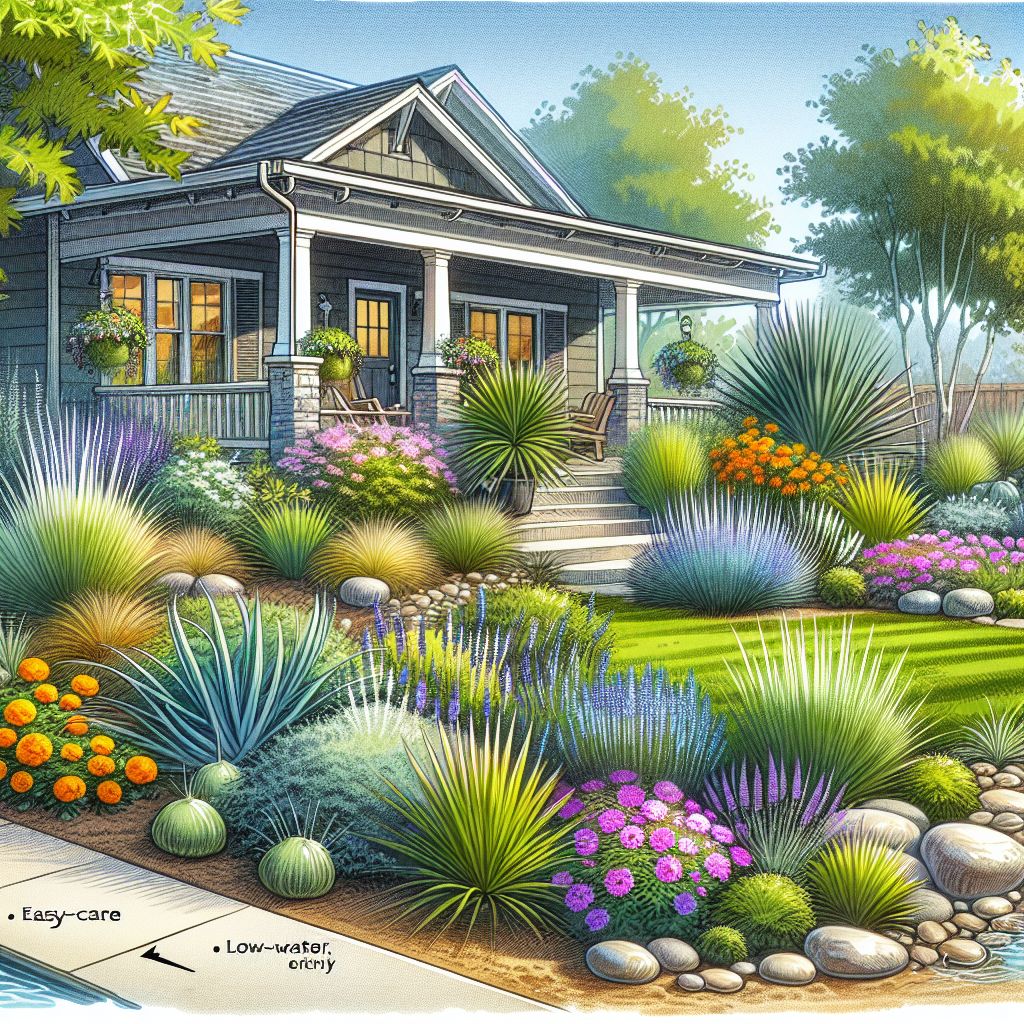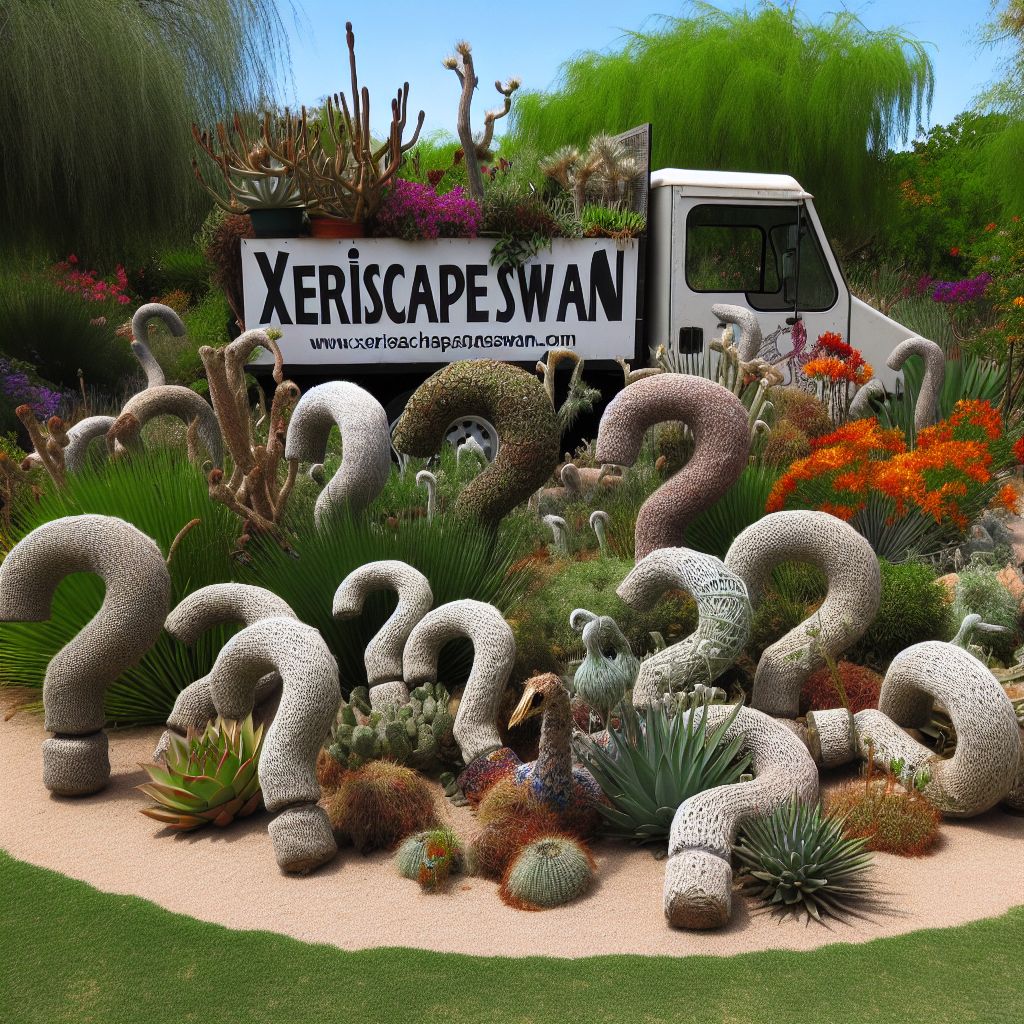
Article-at-a-Glance
- Xeriscaping is a landscaping method that conserves water and is perfect for Illinois’s varied climate.
- Choosing native and drought-tolerant plants can save water and create a vibrant, low-maintenance yard.
- Designing your xeriscape involves understanding your yard’s sunlight, shade, and soil conditions.
- Regular but minimal care can keep your xeriscape garden thriving with less effort than traditional landscaping.
- While the initial cost might be higher,
pays off with significant water savings and reduced maintenance over time.
Transform Your Illinois Front Yard with Xeriscaping
Imagine stepping outside to a front yard that’s not only the envy of the neighborhood but also thrives with minimal effort. This is not just a dream; it’s the reality of xeriscaping. In Illinois, where the weather can swing from snowy winters to scorching summers, xeriscaping is not just a trend—it’s a smart way to garden. It’s about working with nature, not against it.
The Art of Xeriscaping
Xeriscaping is the art of creating landscapes that reduce or eliminate the need for supplemental water from irrigation. It’s about choosing plants that are in harmony with the local climate and soil conditions. Besides that, it’s a creative way to design a garden that’s both beautiful and resilient.
Benefits for the Illinois Climate
Illinois’s climate is diverse, and xeriscaping is a boon for those looking to create a garden that can withstand its extremities. Whether you’re dealing with the humid summers of the south or the cooler temperatures in the north, xeriscaping offers a solution that is both practical and aesthetically pleasing.
Most importantly, xeriscaping in Illinois means you can create a lush landscape that requires less water, which is good for the environment and your wallet. Droughts can hit hard here, and water conservation is increasingly important.
Choosing the Right Plants for Your Xeriscape
When it comes to selecting plants for your xeriscape, native species are your best friends. They’re already adapted to the local climate and soil, which means they’ll thrive with less fuss. Think of plants like the vibrant purple coneflower or the resilient prairie dropseed—both native to Illinois and perfect for a low-water garden.
Drought-Tolerant Flowers and Their Vibrant Appeal
Don’t think that choosing drought-tolerant plants means sacrificing color and variety. On the contrary, these plants can offer a spectrum of colors and textures that rival any traditional garden. For instance, the black-eyed Susan, with its golden petals and dark center, can bring a burst of sunshine to any front yard.
Robust Plants That Thrive in Illinois
When selecting plants, consider their ability to endure the local weather. Plants like the Illinois bundleflower or the butterfly milkweed not only add beauty to your garden but also attract pollinators, playing a vital role in the local ecosystem.
For those who prefer greenery to flowers, ornamental grasses such as big bluestem or switchgrass can provide a lush backdrop or striking focal points. These grasses stand tall against the wind and add movement and life to your xeriscape.
Trees are another component of xeriscaping. They provide shade, which can be a relief during the hot Illinois summers. Species like the bur oak or the eastern red cedar are drought-tolerant and can offer a canopy for other plants in your xeriscape.
Stay tuned for more detailed insights on planning your xeriscape design, maintaining your garden with ease, and understanding the costs involved. We’ll delve into how to map out your yard for sunlight and shade, select the right soil, and budget your landscaping project effectively.
Mapping Out Sunlight and Shade
Before you plant a single seed, take a moment to observe your front yard. Where does the sun rise and set? Which areas bask in full sunlight, and which ones are shaded? Understanding the light patterns of your yard is crucial because plants have different needs. Some crave the sun’s warm embrace all day long, while others prefer the cool, gentle shadows.
Example: A south-facing yard in Illinois will receive the most sun. Here, sun-loving plants like
or coreopsis will thrive. Meanwhile, areas shaded by buildings or trees can become perfect spots for shade-tolerant species like wild ginger or ferns.
Grab a map of your yard, or create a simple sketch. Mark out these areas of sunlight and shade throughout the day. This map will guide you in placing the right plant in the right spot, ensuring your xeriscape is not just survivable, but thrives.
Selecting Soil Types for Optimal Growth
Soil is more than just dirt—it’s a living, breathing foundation that sustains your plants. In Illinois, soil types can range from rich, loamy earth to dense clay. The right soil type can mean the difference between a plant that survives and one that flourishes.
For your xeriscape, you might need to amend your soil with compost or other organic matter to improve its structure and water retention. Remember, well-draining soil is key to preventing root rot in drought-tolerant plants.
Example Plants For Xeriscaping In Illinois
| Plant Name | Description | References |
|---|---|---|
| Schizachyrium scoparium ‘Standing Ovation’ (Little Bluestem) | Drought-tolerant ornamental grass that thrives in full sun | 1 |
| Delosperma Wheels of Wonder | Low-maintenance, drought-tolerant ground cover with vibrant colors | 1 |
| Lavendula Phenomenal | Lavender variety well-suited for xeriscaping projects | 1 |
| Agapanthus Fireworks | Evergreen, drought-tolerant perennial with an extended flowering season | 1 |
| Sempervivum ChickCharms | Hardy, sun-loving succulents that are low-maintenance | 1 |
Maintenance and Care for Your Xeriscape Garden
One of the joys of xeriscaping is the reduced maintenance. But “reduced” doesn’t mean “none.” Your xeriscape garden will still need some love and care, especially as it gets established.
Watering Wisely: Tips on Irrigation
- Water deeply but infrequently to encourage strong root growth.
- Use drip irrigation or soaker hoses to target water directly to the roots, where it’s needed most.
- The best time to water is in the early morning, to reduce evaporation and give plants time to absorb moisture before the heat of the day.
Even drought-tolerant plants need water to establish themselves. Once they’re settled in, they’ll need less water, but those first few months are critical. Pay attention to your plants; they’ll tell you when they’re thirsty.
Minimal Upkeep for Maximum Beauty
Xeriscaping isn’t just about planting drought-tolerant flora; it’s also about designing a landscape that’s inherently low-maintenance. Use mulch to retain moisture and suppress weeds, choose perennials that come back year after year, and group plants with similar water needs together.
And remember, a little pruning goes a long way. Deadheading spent flowers and trimming back growth not only keeps your garden looking tidy, it also encourages new growth and helps prevent disease.
The Price of Xeriscaping: Budgeting Your Landscaping Project
Let’s talk numbers. Xeriscaping can seem like a costly venture at first. You’re investing in new plants, maybe some hardscaping, and perhaps even new soil. But think of it as a long-term investment. You’re creating a garden that will save you water and maintenance costs for years to come. For more insights, explore this guide on optimal low-water gardening.
Estimating Costs for Plants and Materials
Here’s a rough estimate: native plants might cost you between $3 to $10 each, mulch could be around $30 to $50 per cubic yard, and soil amendments might run you another $50 to $100 depending on the size of your yard.
Don’t forget to factor in any hardscaping elements like rocks or pavers, which can vary widely in price. A single large boulder, for example, might cost $100 or more, depending on size and type.
Long-term Savings of a Xeriscape Yard
Now, for the good news. Once established, your xeriscape garden can reduce your water bill significantly—some estimates say by as much as 50% to 75%. And with less grass to mow and fewer plants to baby, you’re also saving on maintenance costs and time. It’s a win-win for you and the environment.

Frequently Asked Questions
What is Xeriscaping Exactly?
Xeriscaping is a landscaping philosophy that involves creating gardens and yards that require minimal water beyond what the natural climate provides. It’s all about selecting plants that are well-suited to the local environment, arranging them in efficient, water-saving ways, and using mulches and hardscapes to reduce evaporation. The goal is a beautiful, sustainable outdoor space that conserves water and is easy to maintain.
How Often Should I Water My Xeriscape Garden?
Initially, your xeriscape plants will need regular watering to establish their root systems. Once established, they’ll require much less water. The frequency of watering will depend on the specific plants you’ve chosen and the weather conditions. A general rule of thumb is to water deeply but infrequently, which could mean once a week or even less often during cooler months.
Keep an eye on your plants for signs of stress, such as wilting or discolored leaves, which might indicate they need a drink. Additionally, investing in a rain barrel to collect rainwater can be a great way to provide natural irrigation for your xeriscape garden.
Remember, overwatering can be just as harmful as underwatering, so it’s important to find the right balance for your garden’s specific needs.
- Water new plants regularly until established.
- Once established, water deeply but infrequently to encourage deep root growth.
- Use collected rainwater when possible to supplement irrigation.
Can Xeriscaping Increase My Property’s Value?
A well-designed xeriscape can indeed increase your property’s value. It demonstrates a commitment to sustainability and can be a strong selling point for environmentally conscious buyers. Additionally, the curb appeal of a xeriscape garden, with its variety of textures and colors, can make your home stand out in the market.
Moreover, the cost savings on water and maintenance can be attractive to potential buyers who are looking for a beautiful yard that won’t require excessive effort or expense to maintain.
Is Xeriscaping a Good Fit for the Illinois Climate?
Yes, xeriscaping is an excellent fit for the Illinois climate. The state’s weather patterns, which include hot summers and cold winters, make it ideal for xeriscaping with native plants that are adapted to these conditions. Xeriscaping can help ensure that your garden is resilient to drought and can survive with minimal additional watering, even during the hottest parts of the year.
By choosing plants native to Illinois, you’ll also be supporting local wildlife and contributing to the preservation of the natural ecosystem. This approach to gardening can help to ensure that your outdoor space is both beautiful and beneficial to the environment.
- Illinois’s diverse climate is suitable for a variety of native, drought-tolerant plants.
- Xeriscaping can provide a habitat for local wildlife and support the ecosystem.
- Adapting to the local climate reduces the need for supplemental watering and maintenance.
What Are the First Steps in Starting a Xeriscape Project?
- Assess your yard for sunlight, shade, and soil type to choose the right plants.
- Research native and drought-tolerant plants that thrive in Illinois.
- Create a design plan that groups plants with similar water needs together.
- Consider incorporating mulch and hardscapes to reduce water evaporation.
- Plan your irrigation system, if necessary, to be as efficient as possible.
Starting a xeriscape project begins with understanding your space. Take note of the sun patterns, the type of soil you have, and the slope of your land. Next, educate yourself on the native plants that will grow well in your area. Sketch out a design that includes a variety of plants with different heights, colors, and textures for a visually appealing landscape.




Leave a Reply